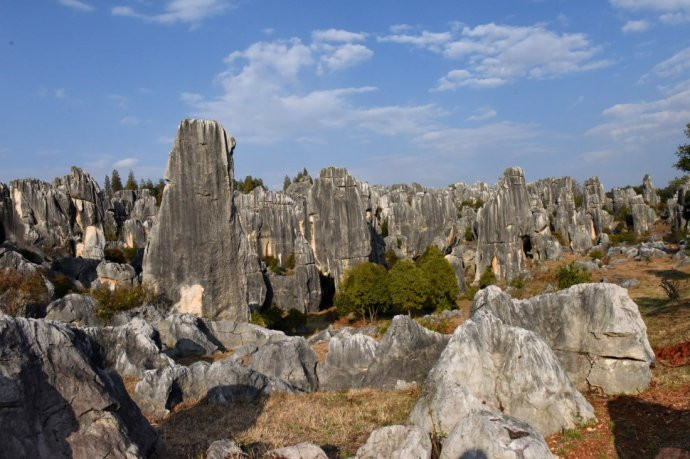
Kunming Geography
Kunming City is located in the central region of Yunnan Province, spanning from 102°10′ to 103°40′ E longitude and from 24°23′ to 26°33′ N latitude. The city stretches 237.50 kilometers from north to south and 152 kilometers from east to west, covering a total area of 21,012.54 square kilometers. Situated at the intersection of the China-ASEAN Free Trade Area, Lancang-Mekong Cooperation Area, and Pan-Pearl River Delta Economic Zone, Kunming serves as a vital gateway to South Asia, Southeast Asia, and even the Middle East, Southern Europe, and Africa. It holds a unique geographical advantage described as “east connects Guizhou and Guangxi to the coast, north reaches Sichuan and Chongqing to the Central Plains, south descends to Vietnam, Laos, Thailand, and Cambodia, west links Myanmar to India and Pakistan.”
Topography
The center of Kunming City is at an elevation of approximately 1,891 meters. The highest point within Kunming’s jurisdiction is the Ma Zong Ridge of Gongwang Mountain, with an altitude of 4,247.7 meters. The lowest point is at the confluence of the Jinsha and Pudu Rivers, with an altitude of 746 meters. The city is located on the Yunnan-Guizhou Plateau, with a general terrain that is high in the north and low in the south, descending stepwise from north to south. The central part is elevated, while the eastern and western sides are relatively low. The primary landform is a karst plateau with lake basins, followed by red hill landscapes. Most areas have altitudes between 1,500 and 2,800 meters.
Climate
Kunming has a subtropical highland monsoon climate, characterized by long sunshine hours, short frost periods, and an annual average temperature of 15°C due to the influence of warm and moist air currents from the Indian Ocean. The city enjoys about 2,200 hours of sunlight per year and a frost-free period of over 240 days. The climate is mild, without extreme heat in summer or severe cold in winter, resembling spring all year round, earning it the titles of “Spring City” and “Flower City.” The annual precipitation is 1,035 millimeters. The temperature in urban areas ranges from 0°C to 29°C, with the smallest annual temperature variation in the country. This rare climatic feature globally allows flowers to bloom year-round and plants to remain green throughout the seasons.
Kunming’s annual temperature variation is minimal, with an average city temperature of about 15°C. The hottest month sees an average temperature of around 19°C, while the coldest month averages around 8°C. Historically, the highest recorded temperature is 31.2°C, and the lowest is -7.8°C. The suitable temperature, moderate humidity, long sunlight hours, and short frost period contribute to the city’s reputation as the “Spring City.” Kunming experiences significant daily temperature variations and high UV intensity, with a saying that “one day can experience all four seasons,” especially noticeable during the winter and spring seasons, where daily temperature differences can reach 12-20°C in winter and 4-10°C in summer.
Main Climatic Features
- Spring: Warm, dry, and with significant daily temperature variations. The average monthly temperature is generally below 20°C.
- Summer: No extreme heat, with concentrated rainfall, accounting for over 60% of the annual total, often leading to heavy rains and floods. The average temperature is around 22°C.
- Autumn: Cool with high, clear skies and reduced rainfall. Temperatures drop quickly, and the season is typically dry, with temperatures about 2°C lower than in spring.
- Winter: No severe cold, abundant sunshine, and little rain. Each month averages about 20 sunny days, with around 230 hours of sunshine and only four rainy days, accounting for just 3-5% of the annual rainfall.
In February 2022, the Ministry of Ecology and Environment ranked Kunming third among 168 key cities in China for air quality.

Hydrology
Kunming City lies in the watershed area of the Jinsha, Nanpan, and Yuan rivers, with rivers belonging to three major water systems.
Natural Resources
Water Resources
Kunming boasts plateau freshwater lakes such as Dianchi and Yangzonghai, along with numerous rivers. The average annual surface water resource is 64.95 billion cubic meters. Dianchi Lake is China’s sixth-largest freshwater lake, covering about 300 square kilometers.
Biological Resources
Kunming is rich in plant resources, featuring various vegetation types, including subtropical evergreen broad-leaved forests, mixed needle and broad-leaved forests, temperate needle-leaved forests, alpine shrubs, and meadows. The city has over 400 traditional flower varieties, and in recent years, numerous new flower species have been widely cultivated in Kunming.
Mineral Resources
Kunming’s main minerals include phosphorus, salt, iron, titanium, coal, quartz sand, clay, silica, and copper, with the richest being phosphorus and salt. Proven reserves of phosphorus ore total 2.277 billion tons, making Kunyang Phosphorus Mine one of China’s three largest phosphorus mines. Rock salt reserves are 1.222 billion tons, and mirabilite reserves are 1.908 billion tons. Dongchuan is one of China’s six major copper-producing bases.
Land Resources
Kunming features highland red soil, primarily consisting of red soil, purple soil, and paddy soil. The region also has extensive geothermal resources, with over 50 exposed hot springs.













